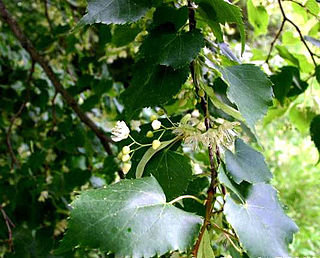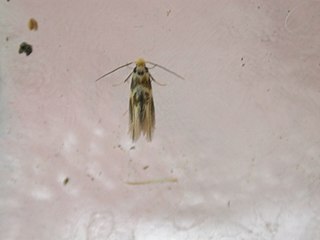
Tilia is a genus of about 30 species of trees or bushes, native throughout most of the temperate Northern Hemisphere. The tree is known as linden for the European species, and basswood for North American species. In Britain and Ireland they are commonly called lime trees, although they are not related to the citrus lime. The genus occurs in Europe and eastern North America, but the greatest species diversity is found in Asia. Under the Cronquist classification system, this genus was placed in the family Tiliaceae, but genetic research summarised by the Angiosperm Phylogeny Group has resulted in the incorporation of this genus, and of most of the previous family, into the Malvaceae.

Tilia cordata, the small-leaved lime or small-leaved linden, is a species of tree in the family Malvaceae, native to much of Europe. Other common names include little-leaf or littleleaf linden, or traditionally in South East England, pry or pry tree. Its range extends from Britain through mainland Europe to the Caucasus and western Asia. In the south of its range it is restricted to high elevations.

Tilia platyphyllos, the large-leaved lime or large-leaved linden, is a species of flowering plant in the family Malvaceae (Tiliaceae). It is a deciduous tree, native to much of continental Europe as well as southwestern Great Britain, growing on lime-rich soils. The common names largeleaf linden and large-leaved linden are in standard use throughout the English-speaking world except in the British Isles, where it is known as large-leaved lime. The name "lime", possibly a corruption of "line" originally from "lind", has been in use for centuries and also attaches to other species of Tilia. It is not, however, closely related to the lime fruit tree, a species of citrus.

Fiber crops are field crops grown for their fibers, which are traditionally used to make paper, cloth, or rope.

The scalloped hazel is a moth of the family Geometridae. The species was first described by Carl Alexander Clerck in 1759.

The scalloped oak is a moth of the family Geometridae. The species was first described by Carl Linnaeus in his 1758 10th edition of Systema Naturae.

Tilia americana is a species of tree in the family Malvaceae, native to eastern North America, from southeast Manitoba east to New Brunswick, southwest to northeast Oklahoma, southeast to South Carolina, and west along the Niobrara River to Cherry County, Nebraska. It is the sole representative of its genus in the Western Hemisphere, assuming T. caroliniana is treated as a subspecies or local ecotype of T. americana. Common names include American basswood and American linden.
The hybrid elm cultivar Ulmus × hollandica 'Ypreau' is one of a number of cultivars arising from the crossing of the Wych Elm U. glabra with a variety of Field Elm U. minor. The tree was first identified by Poederlé in Manuel De L'Arboriste Et Du Forestier Belgiques 266, 1772, as l'orme Ypreau.

Tilia × europaea, generally known as the European lime, common lime or common linden, is a naturally occurring hybrid between Tilia cordata and Tilia platyphyllos. It occurs in the wild in Europe at scattered localities wherever the two parent species are both native. It is not closely related to the lime fruit tree, a species of citrus.

Tilia tomentosa, known as silver linden in the US and silver lime in the UK, is a species of flowering plant in the family Malvaceae, native to southeastern Europe and southwestern Asia, from Romania and the Balkans east to western Turkey, occurring at moderate altitudes.
1229 Tilia is a dark Themistian asteroid from the outermost regions of the asteroid belt, approximately 28 kilometers in diameter. It was discovered on 9 October 1931, by astronomer Karl Reinmuth at the Heidelberg Observatory in southwest Germany, and given the provisional designation 1931 TP1. The asteroid was named for the genus of trees, Tilia (lime tree, linden, basswood).

Tilia johnsoni is an extinct species of flowering plant in the family Malvaceae that, as a member of the genus Tilia, is related to modern lindens. The species is known from fossil leaves found in the early Eocene deposits of northern Washington state, United States and a similar aged formation in British Columbia, Canada.

Bucculatrix thoracella, the lime bent-wing, is species of moth in the family Bucculatricidae, and was first described in 1794 by Carl Peter Thunberg as Tinea thoracella. It is found throughout Europe with exception of Ireland and the Balkan Peninsula, and in Japan, where it occurs on the islands of Hokkaido and Honshu.

Oxycarenus lavaterae, common name lime seed bug, is a species of ground bug of the family Lygaeidae, subfamily Oxycareninae.

Tilia mongolicaMaxim., commonly known as Mongolian lime, is a tree native to mountains of the northern China, growing up to elevations of 1200–2200 m.

Tilia carolinianaMill. is a species of tree in the family Malvaceae native to the southern and south-eastern states of the U.S., and Mexico.

Bastejkalns Park is a spacious park on the eastern edge of the old town of Latvian capital Riga.

Tilia amurensis, commonly known as the Amur lime or Amur linden, is a species of Tilia native to eastern Asia. It differs from the better-known Tilia cordata in having somewhat smaller leaves, bracts and cymes. It is an important timber tree in Russia, China and Korea, and is occasionally planted as a street tree in cities with colder climates.

Tilia mandshurica, the Manchurian linden or Manchurian lime, is a species of flowering plant in the family Malvaceae, native to China, the Korea Peninsula, Japan, and the Russian Far East. It is used as a street tree in its native range, and has potential elsewhere, but is susceptible to damage from late frosts.





















